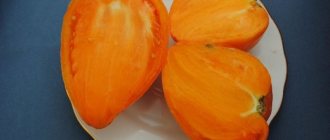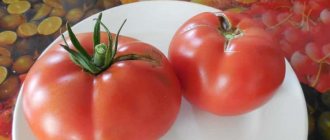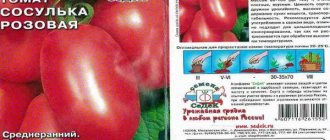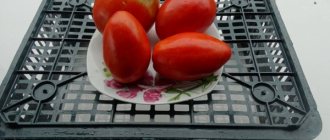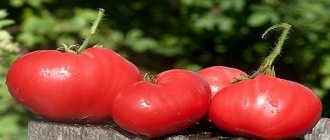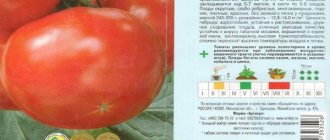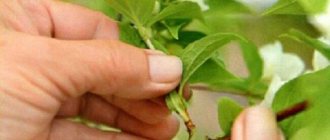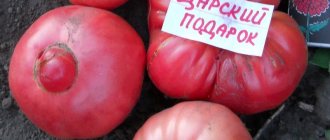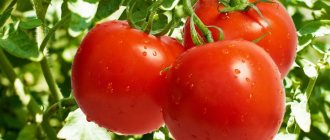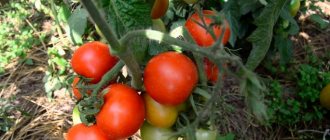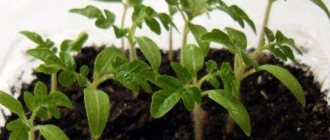The Dulcinea tomato has appealed to many gardeners and gardeners. Pink pears are beautiful and neat, and have a delicious taste. They are also easy to grow.
| Height | Landing location | Ripening time | Fruit color | Fruit size | Origin | Fruit shape |
| Tall | Greenhouse, Open ground | Mid-season | Pink | Large | Variety | Pear-shaped |
Description of the variety
The bushes are indeterminate, so at the beginning of July, careful pinching of the tops is necessary. This will allow nutrients to be directed to the development and ripening of the fruit, and not to the further growth and thickness of the tops. Tomatoes are grouped 4 - 6 pieces in each brush. The first of them is tied above the seventh leaf, and each subsequent one is tied after another 3 leaves. So that the bushes can withstand the load of fruits, they must be tied up. It is best to use the trellis method for this, in which support is provided primarily to the brushes themselves.
The average weight of tomatoes is 150 - 250 g. They can be used fresh, as well as for preparing salads, sauces and juices. If the planting of seedlings grown in March is repeated in the second half of May or early June, then the first fruits can be harvested already in mid-July. The variety has a long fruiting period, so the ripening of the harvest extends until mid-September.
LiveInternetLiveInternet
What are the promising tomato varieties
Is it worth paying attention today? I'll start with the low determinate ones; they are usually grown in open ground or in tunnel greenhouses. For beginning gardeners or busy people who don’t have time to plant or garter tomatoes, I suggest planting two wonderful varieties, “Pepper-shaped strong” and “Solokha”.
Despite the small growth of the bushes, they are strewn with fruits. The undoubted advantage of both varieties is their fairly good resistance to the vagaries of weather and diseases.
Many summer residents classify Dutch hybrids as tasty varieties, considering them more productive. I'm not against Dutch hybrids; they are undoubtedly productive. But I still recommend growing Russian hybrids as they are more tasty. I recommend the tomato hybrids “Bulat”, “Fidelity” and “Generator”. The “Fidelity” tomato ripens early and bears fruit until late autumn, and when collected in the form of green fruits, it ripens well and can be stored for up to 50 days. Tomato “Fidelity” will become your favorite for many years.
Of course, the sweetest are the large-fruited pink and raspberry-colored tomatoes. There are low-growing tomatoes with huge fruits weighing from 500-1000 g - these are “Sugar Pudovichok” and “Hospitable”, which can be grown without pinching, then their fruits will weigh 300 g. And two more large-fruited tomatoes with strange fruits are "Pink Honey" and "Buffalo Heart". The “Buffalo Heart” tomato, with good care, can produce a harvest of up to 10 kg from one bush.
For greenhouse owners, a promising tomato variety called “Scorpio” is suitable - this is a raceme tomato with very large pink fruits of exquisite taste. Collect green fruits in October and they will ripen by November, as they lie well and ripen.
The “Honey-Sugar” tomato variety sets well in both cold and hot summers.
Tomatoes “Laura” and “Dulcinea” give the impression that they were ripening not in a greenhouse, but under the gentle sun. Both tomatoes are racemose; each inflorescence bears up to four to six large fruits.
The next pair of tomatoes, exotic “Scarlet Mustang” and “Goose Egg”. Not only are they very tasty and the bushes are productive, they are also unusual. “Scarlet Mustang” has long, up to 25 cm, cigar-shaped fruits. And the “Goose Egg” has its own charm; it is a racemose tomato with six or eight egg-shaped fruits. “Goose eggs” ripen well.
A couple more interesting Siberian tomatoes are “Uncle Styopa” and “Golden Koenigsberg”. Their fruits are dense and have few seeds. These tomatoes are superior to many others in taste and carotene content. These are the promising tomato varieties
good for drying.
Do not forget that the good yields indicated on the seed packets can only be obtained with good care. See you later, friends!
source Private house. Garden
Recommendations for cultivation
You can count on good tomato yields if you start growing by sowing seeds yourself. Sowing must be carried out 50–60 days before the planned planting in the ground. The container with soil and seeds should be in a bright room at an air temperature of 23 - 25 degrees Celsius. Among the mandatory requirements for growing Dulcinea tomato seedlings, it is worth highlighting timely moderate watering: the soil should be moist, but without excess or stagnation of water, since this blocks the access of oxygen to the root systems. The total growing season takes 108–115 days from the moment the first shoots appear.
Tomatoes are a type of nightshade crop, so any manipulations with the root system of plants can lead to a stop in the development of bushes or an insufficient harvest. In order not to injure the plants during the picking process, you can plant the seeds in separate small containers and then replant them on permanent soil along with a lump of earth.
It can be replanted into permanent soil only after the ground has warmed up to 16 - 18 degrees, and the possibility of a return of spring night frosts will be minimal. Since the bushes grow tall and voluminous, no more than 3 bushes per 1 sq.m. should be planted. 10 days after planting, it is necessary to carefully hill up the bushes. This will retain more moisture inside and also protect the plants from various diseases. Since tomatoes tend to form roots from small shoots on the stems, hilling strengthens the system, which means the plant becomes less vulnerable.
Read also: When to remove cannes for the winter
When choosing a site for growing Dulcinea tomatoes under temporary film cover, preference should be given to well-lit areas or slight partial shade. Planting tomatoes in cold drafts is not allowed.
Original tomato seeds
Cultivating non-hybrid varieties is considered a more risky activity, but these best seeds successfully retain all their properties. Thus, you can independently develop your own method of growing this nightshade crop.
Universally used fruits of the Dubrava variety
The biological description of the variety and characteristics of the Dubrava tomato indicate that the plant is intended for open soil. The bushes grow determinately in recommended conditions up to 60 cm. Ripe tomatoes are round, with small brown spots. The fruit ripens in literally 85-105 days and grows up to 110 g.
Some reviews of the Dubrava tomato suggest that the variety will produce a harvest in a polycarbonate greenhouse. The plant at any stage of development requires sunlight. For this variety, it is recommended to choose sandy loam, light loamy soils. A high humus content is allowed. The yield increases with fertilizing.
Thumbelina
The indeterminate variety is early ripening (90-95 days). Protected soil and polycarbonate greenhouses are the best conditions for the development and fruiting of Thumbelina. For a good harvest, the plant should be shaped and, if necessary, tied to trellises. There are up to 15 fruits in one brush. Red tomatoes are moderately sweet, weighing 15-20 g. The grape-shaped variety is recommended for fresh consumption.
The few negative reviews about the Thumbelina tomato concern the taste of ripe vegetables. Some gardeners note that the variety is sour. In this case, most likely, the bushes were grown in conditions of insufficient natural light.
Pear-shaped Dulcinea
The mid-season tomato Dulcinea produces beautiful raspberry fruits. Large pear-shaped vegetables ripen on a plant up to 160 cm high. In greenhouse conditions, the largest tomatoes can reach 350 g, the average weight is about 200 g. Per 1 sq.m. Seed manufacturers recommend planting three plants at a time. A garter is necessary for an adult bush. Timely fertilizing helps increase the yield of tomatoes.
When cultivating Dulcinea, it is important to know that the first cluster is planted above the 7th leaf. Each subsequent one is after 3 sheets. One inflorescence is 4-6 fleshy fruits with aromatic pulp. Tomatoes, delicate in texture, perfectly complement vegetable dishes. The pleasant taste of ripe tomatoes is due to the harmonious combination of sugars and acids.
Stable in harvest Siberian trump card
A rare variety produces such yields: one fruit reaches 700 g. Due to its characteristics (primarily, resistance to temperature changes and stress), the variety grows well in open ground and is of little use for greenhouse cultivation. But reviews of the Siberian Trump tomato allow us to talk about excellent harvests in greenhouses. The main thing is to protect the plant from pests and viruses.
The fruits ripen on a determinate spreading bush (height up to 80 cm). In any growing conditions, pinching is recommended only up to the first flower cluster. The first and last harvests are large-fruited, so you will need to install trellises. Ripe tomatoes are raspberry-red, flattened, round, ribbed.
Tomato Sevruga – up to one and a half kilograms
High yields are only possible in closed ground conditions, and polycarbonate greenhouses are best suited for these purposes.
Positive reviews about the Sevruga tomato indicate that the plant is generally unpretentious in cultivation. The mid-season variety will produce a harvest 110 days after germination. Over the entire period of development, one stem feeds up to 5 kg of fruit.
At the seedling stage, it is important not to overwater the seedlings. In polycarbonate greenhouses, nightshade culture can appear only at 80 days of age after hardening. Further, the bush develops more boldly and turns into a large, densely leafy plant. The characteristics and description of the Sevruga tomato indicate the culture’s special love for phosphate fertilizers.
To obtain a stable harvest, it is important to prepare the greenhouse itself. Some of the work must be completed some time before the structure is occupied by green “tenants.” It is important to prepare the soil in appropriate proportions. And immediately before planting seedlings, disinfect the soil, for example, with a solution of potassium permanganate. Read the article: Famous high-yielding low-growing varieties of tomatoes for the greenhouse.
Recommendations for soil preparation
The optimal conditions for growing Dulcinea tomatoes are:
- sufficient looseness of the soil,
- its complete fertilizer;
- neutral acidity level;
- compliance with the principles of crop rotation;
- moderate humidity.
The soil must be loose so that the root system can receive the necessary oxygen. Therefore, when choosing soil, you should not choose clayey and swampy soils. Ordinary garden soil can be supplemented with coarse river sand. The second important point concerns regular surface treatment to prevent the formation of crusts.
You need to think about fertilizing the soil in the fall. Bird droppings, manure or rotted compost are suitable for this. In this case, the area must be dug up. Before planting seedlings, mineral complexes with the obligatory presence of calcium, potassium, nitrogen and copper are added to the soil. Fertilization can be done by watering the dissolved elements in warm water. Of the mandatory additional fertilizers, it is also worth highlighting the moment before the first flowers appear and before the fruits themselves begin to ripen. In any case, the use of mineral complex fertilizers should be carried out no more than once every 4–5 weeks.
Sensitive roots do not tolerate increased soil acidity. If plantain, horsetail or buttercup most often sprout on the site, this indicates increased acidity. The condition of such soil can be normalized by adding sifted wood ash or lime at the rate of 20–30 kg per 1 hectare of land.
As for the rules of crop rotation, it is not recommended to grow tomatoes after peppers or any other nightshade crops. Potatoes and legumes are good predecessors to tomatoes. Moderate soil moisture is necessary for adequate nutrition of tomato bushes, while stagnation of water in the soil is much more detrimental than a short drought. When growing Dulcinea tomatoes in greenhouse conditions, it is necessary to maintain soil and air humidity levels of about 60%.
Diseases and pests
One of the most dangerous diseases for Dulcinea tomatoes is fusarium blight, which is manifested by rapid rotting of the root system and plant stems. In order to protect the plants in advance, their seeds are treated with a bright pink solution of potassium permanganate even before sowing. Protecting tomato bushes from sudden changes in air temperature, as well as sudden changes from too dry soil to too wet one, will also prevent the disease from appearing.
To prevent whitefly disease in bushes, you can use a two-day garlic infusion, the preparation of which requires 250–300 g of pressed garlic per 8–9 liters of water. An alternative can be a regular soda solution, which uses 250 g of powder per 10 liters of water. Prepared solutions should be thoroughly sprayed on each bush. The first treatment can be carried out no earlier than 2 - 2.5 weeks after planting the seedlings, and after another week, repeated spraying must be carried out.
Read also: Palm tree with coconuts drawing
Fungicides are often used to control insects. The basic rule for their use concerns the need to carry out the work itself no later than 2 weeks before the planned harvest. Special attention must be paid to your own safety when working with chemical poison. Spraying is recommended to be done early in the morning before sunrise or late in the evening. This will allow the substance to be absorbed into the leaves before it evaporates under the influence of sunlight.
Reviews
For preventive protection of tomato bushes, you can use a two-day infusion of celandine. To prepare it, you need to take 8 - 9 liters of clean water and at least 1 - 1.5 kg of chopped fresh herbs. Spraying is best done in the early morning. The procedure must be repeated again after 10 days, preparing a fresh two-day infusion for this.
In order for the processing of tomato bushes to take place as carefully as possible, seedlings on the site should be planted at a distance of 45 - 50 cm. With the onset of hot summer, it is worth taking care of mulching the root systems: the soil under the bushes can be covered with straw or any other non-woven material that would not allow the sun's rays to pass through to soil and thereby protected the existing moisture from evaporation.
photo by Valentina Nevadovskaya
Description of the tomato variety Dulcinea, reviews, photos
Mid-season, tall, indeterminate tomato variety. Recommended for growing in greenhouses and under temporary film covers.
The height of the bush is up to 1.6 meters; it requires tying to a support and pinching. The best result is when the plant is formed into 1-2 stems. The first brush is placed above the 7th sheet, each subsequent one after 3 sheets. Each cluster contains 4-6 fruits.
Fruit characteristics
photo author Alexey Kulik
The fruits are elongated, large, crimson in color at maturity, weighing 150-250 grams (individual specimens up to 350 g). They have tender, aromatic pulp of excellent taste. These tomatoes are ideal for fresh consumption and home cooking.
Thanks to the harmonious combination of acids and sugars, tomatoes have a very pleasant taste.
Description and characteristics of the variety
Tomato Dulcinea is an indeterminate tall variety. The shoots grow powerful and strong, reaching a height of 1.6-1.8 m. They need pinching due to the stormy growing season. The first cluster with inflorescences is formed after the 7th true leaf, each subsequent one after 3 leaves.
Each bunch produces 5-6 tomatoes.
What are the characteristic features of fruits:
- weight 150-200 g, tomatoes weigh 300 g from the lower clusters;
- raspberry pink color;
- the skin is strong and does not crack;
- the pulp is tender, moderately juicy;
- the taste harmoniously combines sweetness and sourness.
Ripening time is average - 100-110 days from germination.
